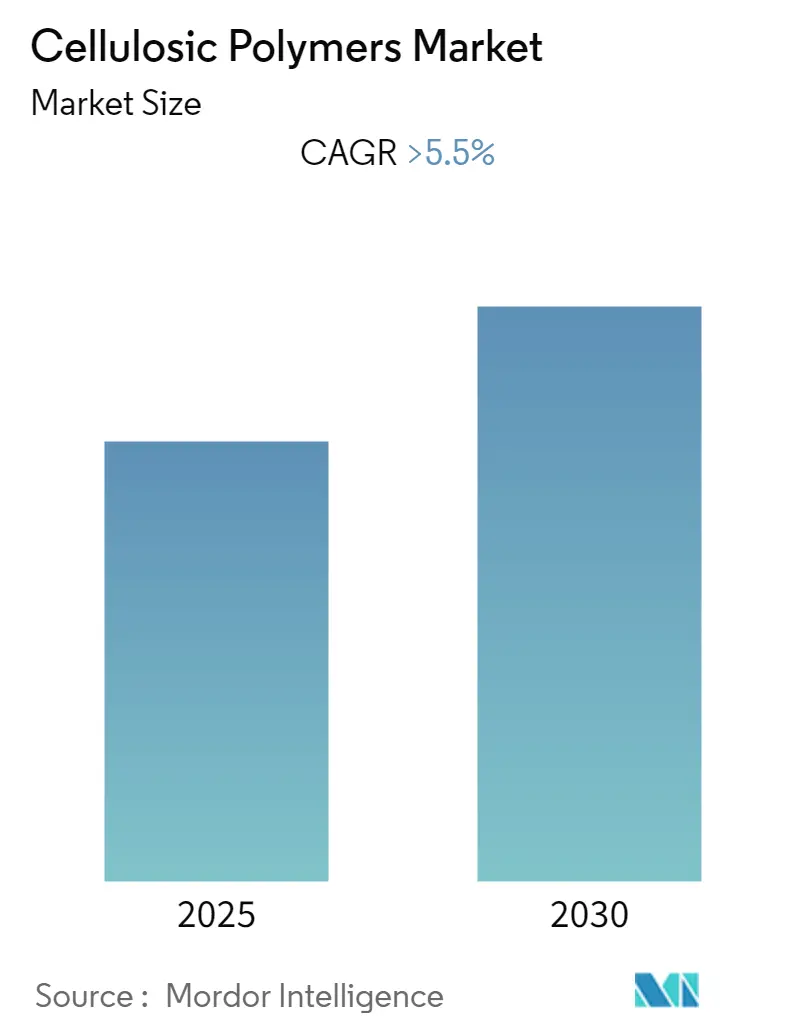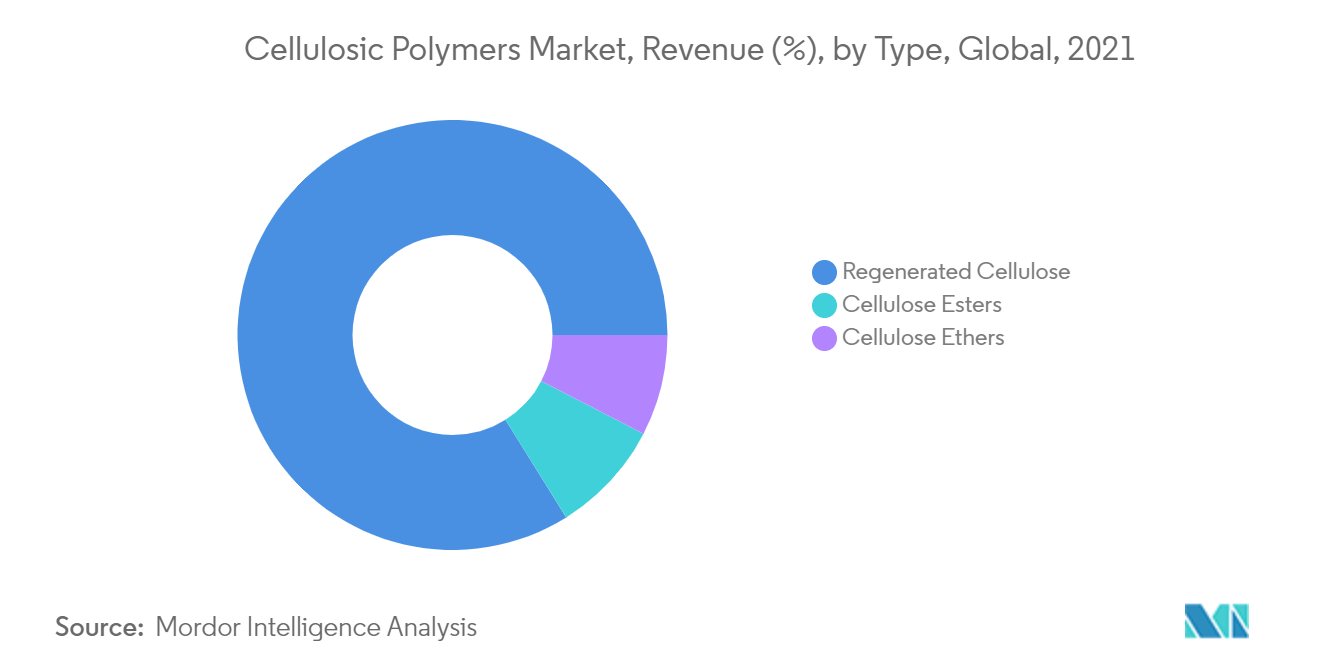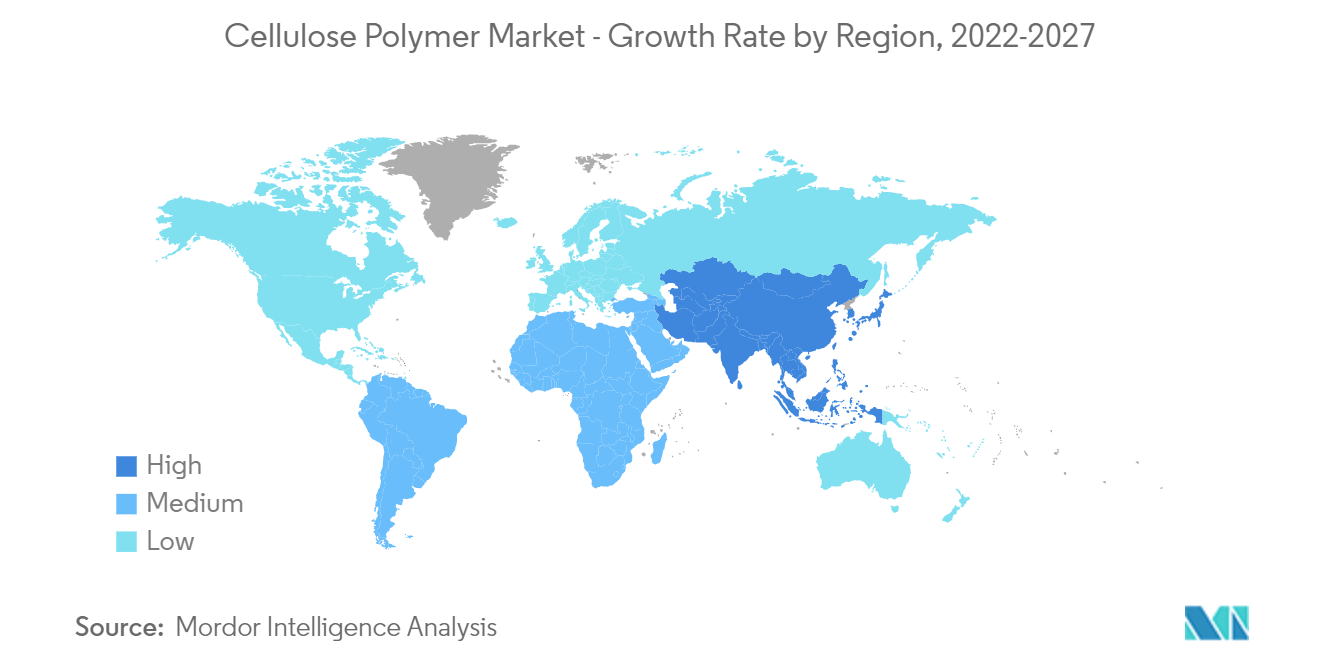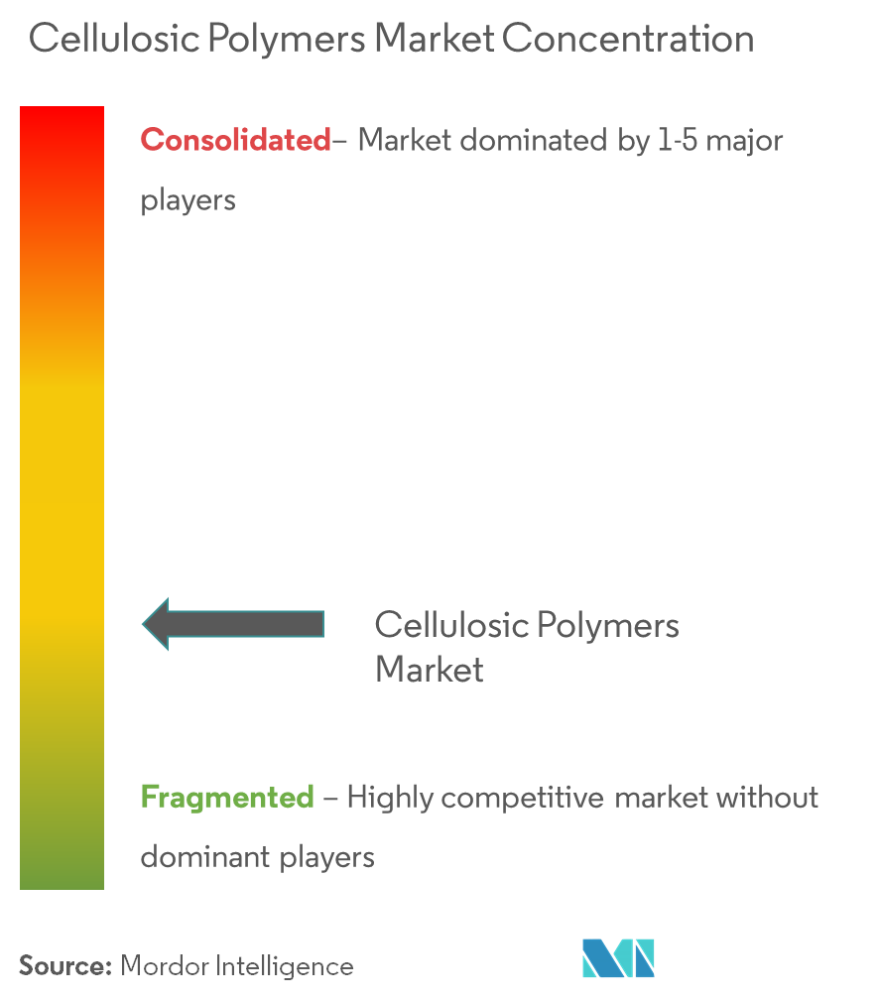Cellulosic Polymers Market Analysis
The Cellulosic Polymers Market is expected to register a CAGR of greater than 5.5% during the forecast period.
The COVID-19 pandemic impacted the market negatively; however, the market has now been estimated to have reached pre-pandemic levels.
- The major factors driving the market studied are the increasing demand for apparel and clothing and the use of cellulose ether in the building and construction industry.
- The competition of regenerated cellulose fibers from synthetic fibers and other protein-based fibers and reduced demand for cigarettes, affecting the market for cellulose acetate flakes, are expected to hinder the growth of the market studied.
- The regenerated cellulose segment accounted for the largest share of the total volume of the market studied.
Cellulosic Polymers Market Trends
Increasing Demand for Regenerated Cellulosic Fibers
- Regenerated cellulosic fibers accounted for an estimated share of more than 99% of the regenerated cellulose polymers market. Viscose, modal, lyocell, and cupro are the major regenerated cellulosic fibers considered in the report.
- Viscose staple fiber (VSF) is a manmade, biodegradable fiber with similar characteristics to cotton. VSF is used in apparel, home textiles, dress material, knitted wear, and non-woven applications.
- Increasing demand for textiles and apparel is expected to drive the demand for VSF in these applications. Asia-Pacific, the largest market for woven fabrics, is witnessing healthy growth due to the increasing demand in countries like India, China, etc.
- Grasim (Aditya Birla) is the major provider of viscose staple fiber in the global market.
- Lyocell is a natural, manmade material made from wood cellulose or pulp. Lyocell material has a very smooth surface and a beautiful appearance. Its elasticity and strength make it perfect for the acquisition of durable items. Hence, it is widely used to produce sportswear. Lenzing is the major provider of lyocell fibers globally.
- Modal is another type of regenerated fiber majorly used in intimates, bed sheets, towels, and bathrobe applications. Lenzing is the major provider of modal fibers globally.
- Cupro is a regenerated cellulose fiber produced by treating cotton cellulose with cuprammonium salts. They are used in apparel, lining, activewear, and home textile applications. Asahi Kasei Corporation is a major provider of cupro fibers.
- Thus, based on the above-mentioned aspects, the regenerated cellulosic polymer segment is expected to dominate the market.
The Asia-Pacific Region to Dominate the Market
- The Asia-Pacific region dominated the global market. China is one of the fastest-growing economies globally, and almost all the end-user industries have been growing due to the rising population, living standards, and per capita income.
- The construction activity in China has been growing at a moderate rate over the last few years. However, the Evergrande Debt crisis may impact the industry negatively.
- The total investment in property has been steadily rising in China. Real estate investment, which is mainly focused on the residential sector, also includes the construction of commercial and office spaces, acting as the key driver for the growth of the construction sector in China.
- China is the largest manufacturer of automobiles in the world. The country's automotive sector observed growth of about 53% in the first nine months of 2021 compared to the same period in 2020.
- India is likely to witness an investment of around USD 1.3 trillion in housing over the next seven years, witnessing the construction of 60 million new homes. The availability of affordable housing is expected to rise by around 70% by 2024 in India. The Indian government's 'Housing for All by 2022' may also be a major game-changer for the industry.
- The aforementioned factors, coupled with government support, are expected to contribute to the increasing demand for cellulosic polymers in the region during the forecast period.
Cellulosic Polymers Industry Overview
The cellulosic polymers market is fragmented, with no clear leader in the market. Major players in the market (in no particular order) include Lenzing AG, Ashland, Xinjiang Zhongtai Chemical Co. Ltd, Daicel Corporation, and Eastman Chemical Corporation.
Cellulosic Polymers Market Leaders
-
Ashland
-
Daicel Corporation
-
Eastman Chemical Corporation
-
Xinjiang Zhongtai Chemical Co. Ltd
-
LENZING AG
- *Disclaimer: Major Players sorted in no particular order
Cellulosic Polymers Market News
- The recent developments pertaining to the major players in the market are being covered in the complete study.
Cellulosic Polymers Industry Segmentation
Cellulosic polymers are polymers derived from the naturally occurring celluloses majorly found in plants. The market is segmented by type (cellulose esters, cellulose ethers, and regenerated cellulose) and geography (Asia-Pacific, North America, Europe, and Rest of the World). The report also covers the market size and forecasts in 10 countries across the major regions. The report offers the market size and forecasts in terms of volume (kiloton) for all the above segments.
| Type | Cellulose Esters | Type | Cellulose Acetate | |
| Other Types (CAB and CAP) | ||||
| Application | ||||
| Cellulose Ethers | Type | |||
| Application | ||||
| Regenerated Cellulose | Type | Fibers (Viscose, Modal, Lyocell, and Cupro) | ||
| Films (Hydrated Cellulose Foils) | ||||
| Application | ||||
| Geography | Asia-Pacific | China | ||
| India | ||||
| Japan | ||||
| South Korea | ||||
| Rest of Asia-Pacific | ||||
| North America | United States | |||
| Canada | ||||
| Rest of North America | ||||
| Europe | Germany | |||
| United Kingdom | ||||
| Italy | ||||
| France | ||||
| Rest of Europe | ||||
| Rest of the World | South America | |||
| Middle-East and Africa | ||||
Cellulosic Polymers Market Research FAQs
What is the current Cellulosic Polymers Market size?
The Cellulosic Polymers Market is projected to register a CAGR of greater than 5.5% during the forecast period (2025-2030)
Who are the key players in Cellulosic Polymers Market?
Ashland, Daicel Corporation, Eastman Chemical Corporation, Xinjiang Zhongtai Chemical Co. Ltd and LENZING AG are the major companies operating in the Cellulosic Polymers Market.
Which is the fastest growing region in Cellulosic Polymers Market?
Asia Pacific is estimated to grow at the highest CAGR over the forecast period (2025-2030).
Which region has the biggest share in Cellulosic Polymers Market?
In 2025, the Asia Pacific accounts for the largest market share in Cellulosic Polymers Market.
What years does this Cellulosic Polymers Market cover?
The report covers the Cellulosic Polymers Market historical market size for years: 2019, 2020, 2021, 2022, 2023 and 2024. The report also forecasts the Cellulosic Polymers Market size for years: 2025, 2026, 2027, 2028, 2029 and 2030.
Our Best Selling Reports
Cellulosic Polymers Industry Report
Statistics for the 2025 Cellulosic Polymers market share, size and revenue growth rate, created by Mordor Intelligence™ Industry Reports. Cellulosic Polymers analysis includes a market forecast outlook for 2025 to 2030 and historical overview. Get a sample of this industry analysis as a free report PDF download.






